1962 United States Grand Prix race report: Brits conquer the Glen
Jim Clark leads home Graham Hill as the British pair lap the entire field
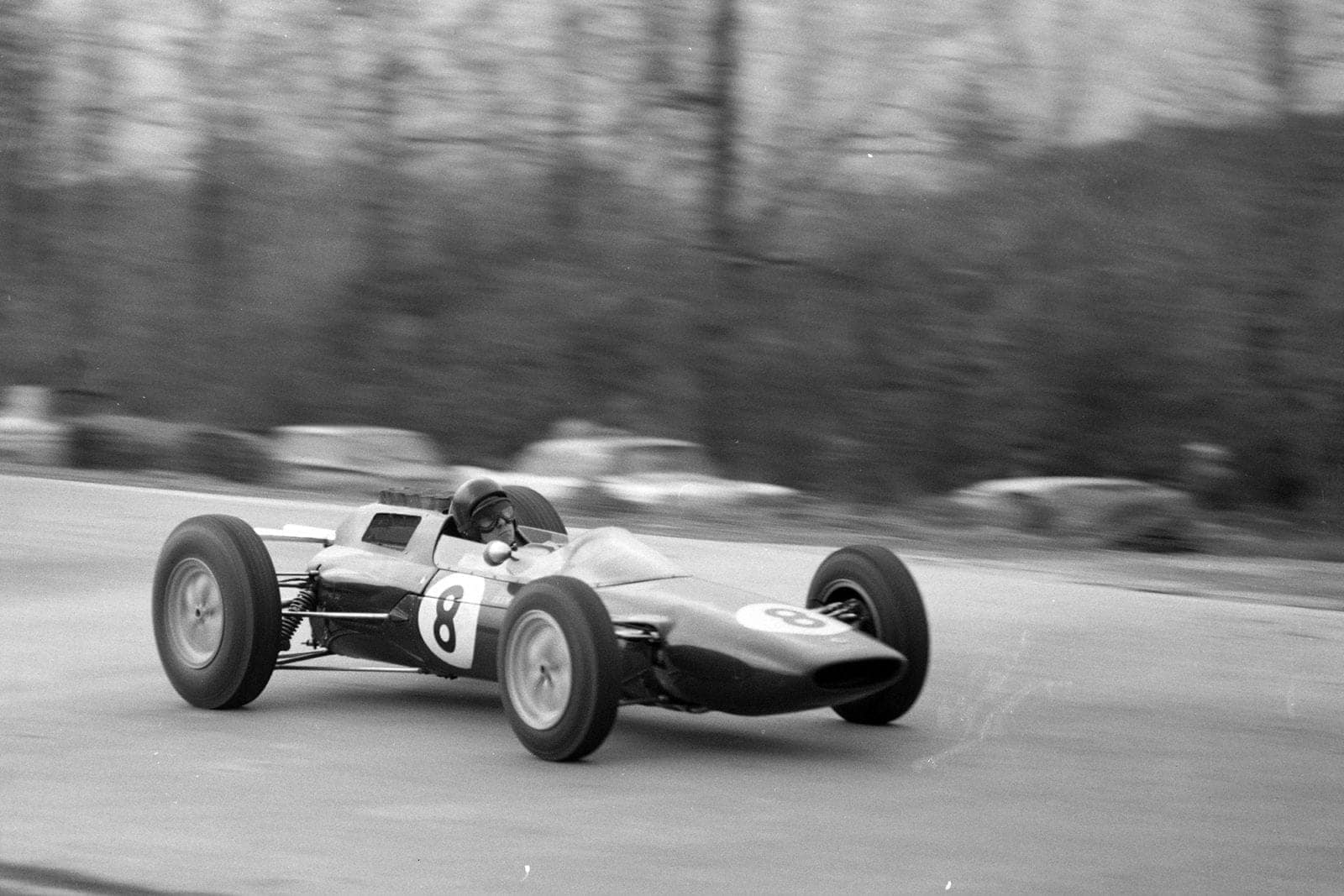
Jim Clark took his third win of the year for Lotus
Motorsport Images
The success of last year’s race guaranteed the return this year to Watkins Glen of the Fourth US Grand Prix. Whereas last year the Drivers’ Championship had been settled before the race started, this year’s race could still mean a change in the final result.
Watkins Glen, situated in North-West New York State, is the area known as the Fingers Lakes Region and is on the southern tip of Lake Seneca. Many circuits are situated in beautiful surroundings but, at this time of the year, few can be as lovely as these woods with the magnificent colouring that Autumn gives the trees, some green and others going through shades of brown to pinks and reds.
The 2.3-mile circuit is situated 5 miles south of the town, high above the lake, and the weather, which is beginning to get temperamental at this time of the year, can be very different in the two places.
The 20 entries lacked the red cars from Maranello, and the excuse this year seemed to be a repetition of last year and that was that strikes made it impossible to prepare the cars in time. So, once again, World Champion, Phil Hill, was robbed of the chance to show his fellow countrymen how well he can drive. To cap his disappointment, he was told from a reliable source that Enzo Ferrari had sacked him.
The cars that were here were from all the other major teams. BRM had three cars for G Hill and R Ginther – the former driving “old faithful” as the mechanics call the first of this year’s cars which was tried at Monza in 1961 and which won at Monza three weeks ago. Ginther’s car was the spare one from Monza whilst the “T” car here was driven by him into second place in the Italian GP.
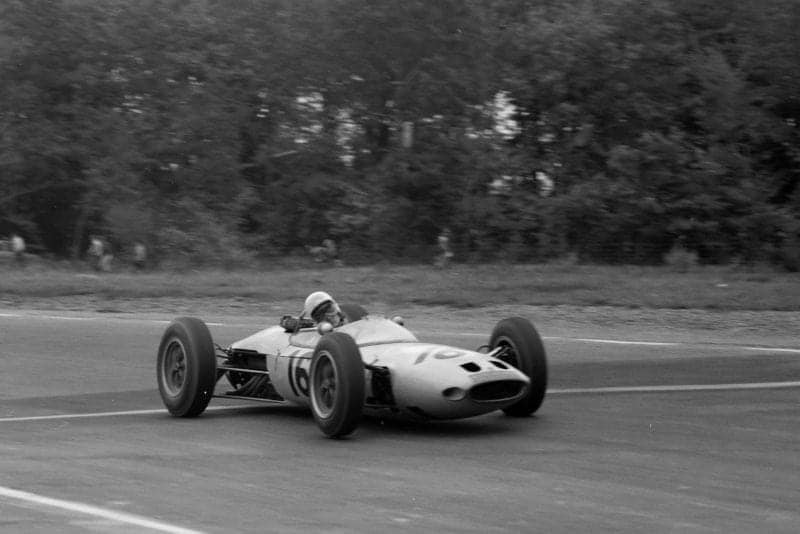
Masten Gregory in the UDT Lotus – BRM
Motorsport Images
Team Lotus had two “monocoque” 25s for Clark and Taylor, these being the same two ill-fated cars that had so much trouble in Italy. Since the Italian GP, ZF had rebuilt the gearboxes so the troubles that haunted the team at Monza, it was hoped, would remain there. Porsche brought two flat-8s for Gurney and Bonnier. The binding tape over the rear wishbones had been removed from Gurney’s car while still remaining on Bonnier’s. The freewheeling of the cooling fan at high speeds described in the Italian GP report was not on the cars as it had proved unsatisfactory.
UDT – Laystall had brought three cars, two entered by themselves for Ireland and Gregory – the Climax-engined car for the former and the BRM-engined car for the American. The only change was that the exhaust pipes of the BRM engine now go down and backwards as on the works car instead of up as they were at Monza. The third car was on loan to Dupont Team Zerex who had entered it for Roger Penske, the up-and-coming American boy. This car was painted the colour of a tin of Zerex Anti-Freeze, which is a sort of mustard.
Surtees and Salvadori were both entered by Bowmaker in Lolas. Surtees’ car was the old one while Salvadori’s was his usual car. John Cooper had two cars in Monza trim except that Maggs was driving the car with the long-range fuel tanks whilst McLaren had swapped to the normal car.
RRC Walker had two cars here, one entered by himself for Trintignant which was the one Vaccarella used at Monza whilst Trintignant’s Monza car was on loan to John Mecom Jr, the young oil millionaire who had entered the re-sprayed (pale blue) Lotus V8 for his friend Bob Schroeder – a completely unknown driver from Texas.
Making up the private entries were de Beaufort with his orange Porsche, as raced at Monza, Brabham with his turquoise-coloured Brabham which was basically as it had been raced before but now the front disc brakes were enlarged and the springing had been changed to improve road-holding. Tim Mayer was entered, according to the programme, by the Cooper Car Company. The car was the ex-Roger Penske 1961 Cooper with the Tommy Atkins’ Mk II 4-cylinder Climax engine. Hap Sharp had entered his 1960 Cooper with Mk II 4-cylinder engine, which was the spare car taken to Indianapolis by Coopers while Jim Hall had entered his ex-Jack Brabham Lotus 21 and this rounded off the 20 entries.
Qualifying
* * *
First practice was from one to five pm on Friday and though it had rained a lot in the morning, the track had just about dried out by the time the first cars moved off. The targets as far as times were concerned were last year’s fastest lap 1min 18.2sec, fastest practice lap 1min 17sec and the outright record in a Formula Libre car held by Moss at 1min 16sec.
First out were McLaren, Clark and Taylor, followed shortly by Ginther, Gurney, Penske, Mayer and Surtees. The Lola in which Surtees was practising had new bearings and was therefore being run-in for a large part of the day. Ginther, who was racing here for the first time, started setting the pace with 1min 23sec but it wasn’t long before Hill (BRM) had equalled his team-mate. Clark’s Lotus was clocking 1min 25sec, while Gurney started to have a go in the Porsche. This eventually resulted in a time of 1min 21.8sec.
After an hour, the times were getting under 1min 20sec, still with the American driver’s BRM leading the way. By half-way through the first session, the two BRMs had clocked 1min 17.9sec while 0.1sec behind came Clark’s Lotus and Brabham in his own car. Gurney’s Porsche was very close to these fastest times but Bonnier, who was suffering from a bad back, was 1.0sec behind his team-mate. The two Lolas were still slower than 1min 20sec while UDT were having engine trouble with Ireland’s car, one of the tappets having broken up, which meant Innes never bettered 1min 24sec. Gregory who was going quite well at this stage in practice, with a time of 1min 38.3sec, later dropped to 1min 17.9sec and then decided the BRM engine was down on power.
Still to go out after two hours’ practice were Sharp, Hall, and Schroeder, although their cars were in the pits. McLaren’s Cooper had its gear ratios changed while de Beaufort’s mechanic was cleaning filth from the Porsche’s carburetter. Several cars were having spring and damper settings adjusted, anti-roll bars were being changed and disconnected for the track is bumpy all the way round with odd cambers on some of the corners. BRM changed the rear camber on Hill’s car while Graham practised in the “T” car.
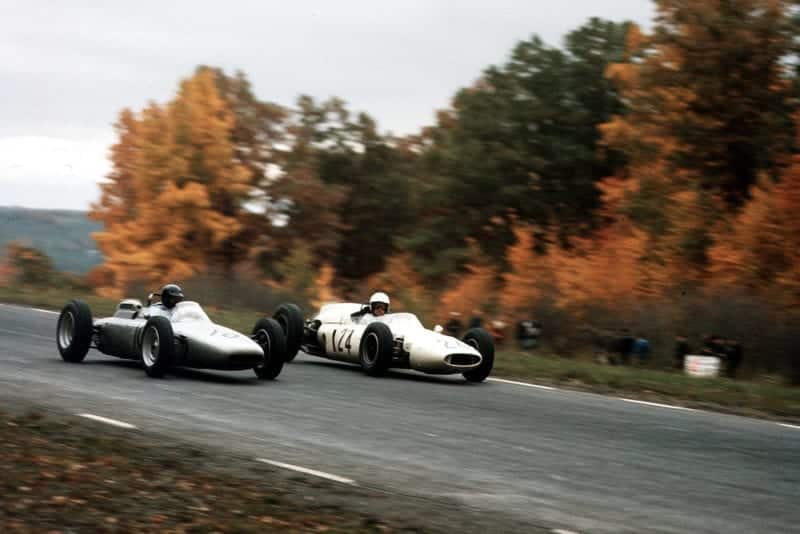
Gurney passes Sharp
Motorsport Images
In the second half of this four-hour session things began to warm up. Ginther got below 1min 17sec followed quickly by Hill. Then Gurney also bettered last year’s best practice lap with a 1min 16.9sec, but Bonnier, in the other Porsche, was going slower as he felt less comfortable with his back. The next to get under 1min 17sec was Jack Brabham, which proved that he had sorted out many of the original “bugs” from his car. McLaren and Maggs were both trying hard but were unable to get below 1min 17sec as was Taylor in the Lotus. Clark went out towards the end of practice, and after only a few laps proved that the Lotus 25 is the fastest F1 car by clocking 1min 15.8sec, faster by 0.2sec than the outright record and fastest practice time of the day.
Among the private entrants Tim Mayer’s Cooper was fastest with 1min 20.7sec de Beaufort was a bit behind at 1min 21.8sec while the unknown Schroeder, in the potentially fastest of the privately entered cars, could only get down to 1min 24sec. As practice came to its close, Surtees was out putting in some faster laps when, at the far loop, a steering arm broke by the ball joint and the car went off on the outside of the course plunging into the bushes at the same place as Ireland did last year. Unlike Ireland, however, Surtees hit a big tree, completely wrecking the front of his car. John was, fortunately, only shaken up and walked back to the pits but Bowmaker were left with only one car.
“Surtees hit a big tree, completely wrecking the front of his car. John was, fortunately, only shaken up and walked back to the pits”
On Saturday, the rain which had held off during the first session, poured down and when practice was due to start most drivers and cars kept well under cover. An hour after practice had officially started, the rain eased a little and the two BRM drivers and Jimmy Clark got in some wet practice. Hill managed to get down to 1min 26.5sec but the Lotus, which is not as stable as the BRM in wet conditions, could only record 1min 31.2sec.
As the rain cleared, more cars turned up, but the Lotus of Jim Hall and the Cooper of Hap Sharp failed to turn up at all. UDT were very late arriving as they had changed engines overnight. Ireland arrived an hour from the end, and Gregory just got in a few laps after official practice had closed.
With the track so wet cars were continually spinning in front of the pits as they came out of the sharp right-hander outside the pit road. Salvadori handed his car over for Surtees to practise in and to race the next day, but biggest surprise of all came when Phil Hill, who was walking about with a very long face, suddenly appeared in the flat-8 Porsche which Bonnier had been driving. The Swede’s back was still troubling him and he handed over to Phil to get a practice time in case he was unable to start on the Sunday. Practice ended with most of the first day’s times counting for the grid, and the contest between Hill and Clark seemed more certain as on the drying track they had both recorded 1min 22.1sec, a very equal contest and one on which the Drivers’ Championship was hinged.
Race
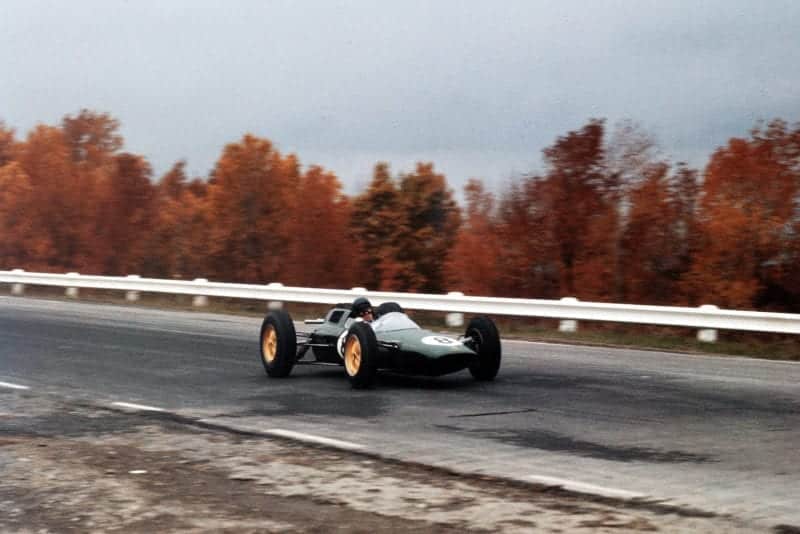
Clark started from pole
Motorsport Images
Race day was dry and cloudy. A large crowd from Canada and surrounding States had begun arriving during the night, and by the time the race started it was estimated at between 40 and 45 thousand. Jim Hall, who missed the second practice, had withdrawn as on the first day a valve guide had broken and he was unable to get it repaired in time. Also missing, of course, was the Surtees Lola, but John was to drive Salvadori’s car, which had certain parts swapped from his crashed car. Bonnier had recovered enough to drive, so Phil Hill had to spectate.
The drivers were called to the usual pre-race meeting where the lavender-suited starter explained his repertoire, and then they were off on the warming-up lap. The grid was formed at the Glen in two’s, the two contenders for the Championship one behind the other at the front and Surtees at the back, the reason for John’s position being that he only practised for a short time in the wet in Salvadori’s car.
With a great flourish from the starter and the crescendo of sound which is part of racing, the field swept away through the right-hander, up the hill and on to the first lap. As they went over the hill, Clark was leading from Hill’s BRM, McLaren, just behind, slightly over-revved his engine in this first burst of speed, which took the edge off it for the rest of the race.
“As the cars roared past after the first lap, Clark led by a few yards from Hill, with Ginther, Brabham, Gurney and McLaren in a group a short way behind”
As the cars roared past after the first lap, Clark led by a few yards from Hill, with Ginther, Brabham, Gurney and McLaren in a group a short way behind. Another gap separated Bonnier, Taylor, Ireland and Gregory, while at the back came Mayer, Schroeder, Surtees, Sharp, Trintignant and de Beaufort. The two leaders soon began to draw away from the rest of the field and Clark opened up a few yards between his Lotus and the BRM. As the cars settled into the swing of things, Surtees passed some of the tail-enders to move up from 15th to 11th place by lap six. The pace at the front was such that the F1 lap record was lowered from the third lap onwards.
Gurney moved through the second batch of cars from fifth to third, passing Brabham on one lap and Ginther’s BRM the next. Here he stayed with Ginther breathing hard down his neck until the tenth lap when the BRM’s driver regained his third place.
The leaders were now well away from the rest of the field. Ireland made a brief pit stop after he found he was selecting 3rd instead of 5th gear on occasions, putting him to the back of the field. On the eighth lap, Taylor also made a pit stop with oil pressure trouble; oil was poured in and he went out again, but the trouble persisted all through the race although it didn’t affect the engine. On the tenth lap, de Beaufort came in very slowly with the rear suspension of his Porsche broken from sharp contact with a guard rail, and his left-hand rear wheel was waving through about 30 degrees. At the same point and at the same time, Bonnier’s Porsche spun and hit the same guard rail, which caused gear selector trouble for the rest of the race.
The duel for first place took a turn on the 12th lap. Clark had difficulty passing a back-marker on two occasions and Hill took the opportunity to first close the gap and then to pass into a reasonable lead. The four cars in the second group were still very closely bunched in the order Ginther, Gurney, Brabham and McLaren. With cars now being lapped continuously, the spectators away from the loudspeakers were getting confused about the middle of the field but as far as the first six places were concerned there was no mistaking what was happening.
Clark put the pressure on, and his times came down to 1min 15.4sec as he began to overhaul the BRM, and on the 19th lap he shot past into the lead, which he held to the end. Ginther, lying third, began having difficulty changing gear and although it didn’t seem to affect him much to start with he dropped two places on the 26th lap due to this trouble. Back in seventh place, Gregory was leading Maggs, who had a rough car, while behind them Roger Penske was ahead of Ireland’s UDT Lotus.
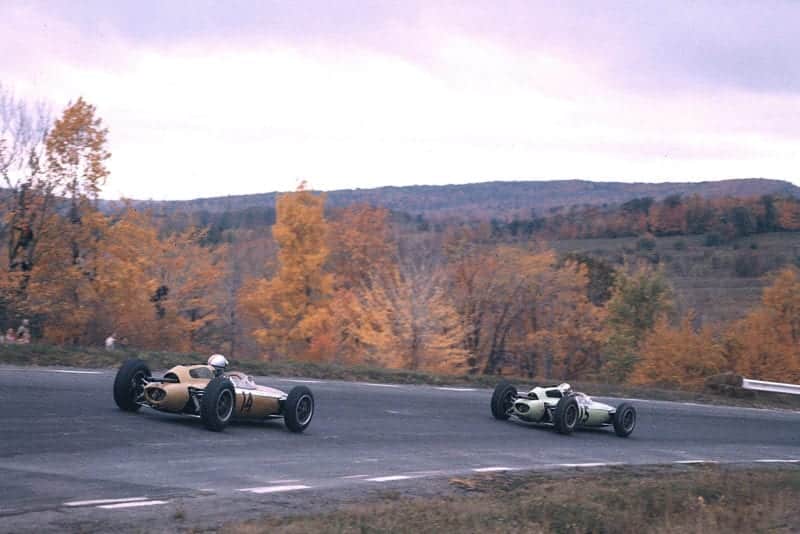
Roger Penske chases Innes Ireland
Motorsport Images
Schroeder was lapping on his own in 11th place, while behind him came Sharp, Mayer, Trintignant, Taylor and Bonnier. Surtees had retired the Lola on the 20th lap with a broken oil pipe. Just after the 30th lap three cars retired in quick succession. First Tim Mayer’s Cooper went on to three cylinders, then died altogether. One lap later Trintignant retired with no brake fluid, having lost two laps earlier with an excursion into the woods when the trouble started. On the 35th lap Ginther, who was lying third until then, pulled into the pits and retired. The official reason given was loss of oil, this no doubt due to the rod which had come through the side of the engine.
“There was no let-up on the speed of the leading cars”
The race had now settled into a pattern and the position over the next 15 laps remained unaltered, but even though positions didn’t change there was no let-up on the speed of the leading cars. Gurney, who was in third place at this point, was being overhauled slowly by McLaren’s Cooper and on lap 57, after holding him off as long as he could, the Porsche driver dropped back to fourth place. His team-mate, Bonnier, was still calling into the pits fairly regularly and was now 19 laps behind the leader.
Farther back in the race Ireland had caught Penske and on the 54th lap the UDT driver moved up from ninth to eighth place, two laps behind the flying Scotsman, who was ensuring Lotus of their second United States GP victory in two years. Gurney’s Porsche was tiring and it wasn’t long before the gap between him and Brabham lying in fifth place began to shrink, until on the 68th lap Jack passed into fourth place, where he stayed until the end.
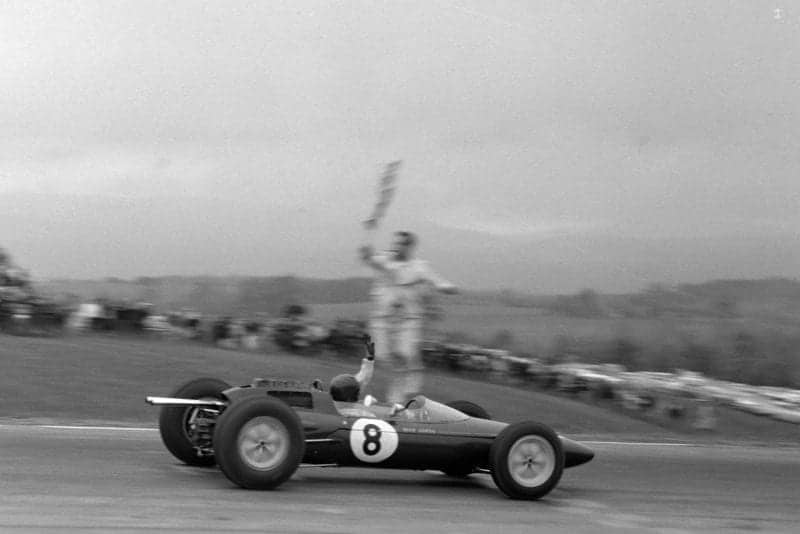
Clark takes the chequered flag
Motorsport Images
At the front the Lotus and BRM were still being kept at the same terrific pressure, 17sec apart. On the 70th lap, Clark set a new all-time lap record of 1min 15sec, a speed of 177.667kph, and Graham was not losing much ground, so it can be seen that both cars were well inside their best practice times. Gurney and Brabham were still in close company but the sickening Porsche was only just able to hold the Brabham.
For the last thirty laps Hill’s BRM was the only car on the same lap as the leader and although Hill closed the gap slightly in the remaining laps, the chequered flag heralded Clark’s Lotus the winner of the 4th United States GP at record speed, while 9.2sec behind came the BRM. One lap down were McLaren (Cooper), Brabham (Brabham), Gurney (Porsche), and Gregory (Lotus BRM), the first five places going to five different cars. Seventh came Maggs (Cooper), three laps down, while eighth and ninth were Ireland and Penske. The unknown Schroeder was 10th, seven laps behind, with Hap Sharp two laps behind him. Taylor’s Lotus completed 85 laps and Bonnier 79 laps The other seven cars which had started had retired.
The points’ situation at the end of this race for the World Drivers’ Championship are that if Clark wins the South African GP he is Champion. If he doesn’t win, Hill is World Champion.
WATKINS WARBLES
- Tony Rudd said after the race that BRM must get rid of some weight before the South African GP.
- England must be one of the only countries where police in the pit area don’t need guns. The Watkins Glen variety have revolvers in open holsters.
- Team shambles? Not this time!
